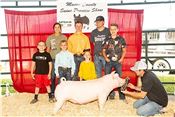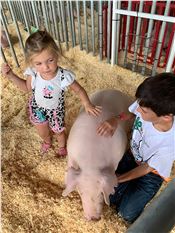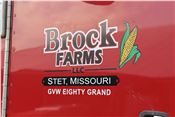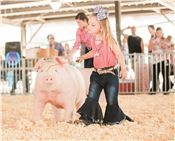Show Rings And Soybeans
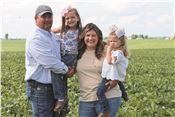
Photos courtesy of the Brock family.
Try hard, don’t cry and do your best.
MADELYN WARREN
JEFFERSON CITY, MISSOURI
If you were to ask expert showman and precocious six-year-old, Chesney Brock what it takes to be successful in the show pig industry, this would most likely be her response.
Chesney, the daughter of Missouri Soybean Association (MSA) treasurer Cody, and his wife Paige Brock, was born into the show ring and soybean world. At the ripe age of four, she could be found in the arena, expertly driving her gilt toward the judge. With only two years under her belt, Chesney has already developed the polish and intensity of more experienced showmen. Her signature style – a bow in her hair, flared bell bottoms and glint in her eye – indicates that she means business.
When describing the three rules of showing pigs, her father, Cody, shared that Chesney herself sometimes struggles with following them.
Chesney agreed.
“I used to cry a lot when I’d lose but I don’t anymore since I get penned,” said Chesney.
The opportunity to learn and grow is what it’s all about for the Brock family. Cody and Paige want to make sure that their children, Chesney (6) and Bellamy (3), have the same experiences both on the farm and in the barn that they did growing up. Like many couples in agriculture, the Brock parents never imagined life any differently.
“I grew up showing pigs and other livestock, and so did my wife Paige,” said Cody. “I’ve realized that the experiences that kids gain at an early age just by having a project like this are priceless.
I think the responsibilities and the network they’ll gain with their peers is something that many kids don’t get exposed to. I’ll argue until I’m blue in the face that our kids are going to get more out of the show ring and from their involvement in 4-H and FFA than almost any other extra-curricular.”
Cody began his hog project the summer before his freshman year of high school to ensure that he had a strong supervised agricultural experience (SAE) for FFA. Soon after, Cody got a taste of the show ring. In fact, Cody fondly recalls the days when he would miss school or ball games to load up hogs with his dad or grandfather to go to a jackpot show.
“Growing up, other parents would always ask my dad – who was the president of the school board at the time – why I was missing ball games,” said Cody. “My dad said, ‘I’ve always told him not to let school get in the way of his education. So yeah, he’s going to go show pigs.’”
As a former educator, Paige probably wouldn’t condone that statement.
However, she certainly recognizes the value in the skills and traits that are instilled in children involved in agriculture.
“I have a passion for kids that can become a voice for agriculture because they are involved in the grit and the dirt of it,” said Paige. “With 4-H and FFA, whether it is cake decorating, public speaking or showing livestock, there are so many opportunities on the table to develop both the soft and hard skills that they will use in real-life situations.”
The show stock world has also given the Brock family something more valuable than a specific set of skills, it has given them a community.
Last year, the show pig community came together to honor Paige’s father, Mike McCrory, who unexpectedly passed away. At the Summer Type Conference, a national level show, Paige’s brother had the opportunity to sell a special Berkshire boar name in honor of Mike.
The hugs, tears and high fives after the sale is what reminded the Brock couple and McCrory family of the thoughtful community that surrounded them during that bittersweet day.
“I felt like for my brother and I, it was almost like my dad’s parting gift,” said Paige. “That is a moment that I will always cherish and remember forever.”
“When it comes to the livestock side of things, we’re definitely not in it for the money,” she says with a chuckle. “We’re in it for the life lessons.”
Those life lessons are taught both at home and in the soybean field as well. Each member of the multi-generational farm family has their own unique job on the operation. Whether it is helping Cody scout beans, calling in the cows or helping their uncle during farrowing season; the Brock girls certainly have their work cut out for them.
“My grandpa’s favorite saying is you’re not gonna learn any younger,” said Cody. “He and my dad always had me learn things at a young age, like driving a tractor. I want my girls to grow up the same way.”
As one of the largest consumers of soy, the Missouri pork industry has an implied value of over $150 million, greatly adding to the demand of the state’s number one commodity. In fact, in 2020 hogs consumed approximately 650 million pounds of soybean meal which is the equivalent of about 14 million bushels of demand specifically due to pork production in the state.
While last year’s high soy prices may have benefited Cody in some ways, they also meant that he had to consider the costs associated with them. Unfortunately, a rise in feed prices was one of them. As a farmer of both pork and soybeans, Cody uses these situations as an opportunity to teach his children about the unique, full circle moment happening on their farm and to help them understand both the benefits and challenges of being involved in the soy value chain.
“I think it’s neat that they get to experience the first line of production for their show pigs’ feed,” said Cody. “It really is a full-circle moment. At just three- and six-years-old, they know that it is corn and soybeans that are going into the feed.”
Cody grins with a look of pride on his face. “As we drive past the fields, Bellamy will tap me on the shoulder and tell me, ‘Good job, Daddy. Good job.’”
In those moments, Cody often reflects on the three rules he gives his daughter, Chesney, in the show ring: try hard, don’t cry and always do your best. ∆
MADELYN WARREN: Communications Coordinator, Missouri Soybean Association, Missouri Soybean Merchandising Council
Note: This article printed with the permission of the above.
